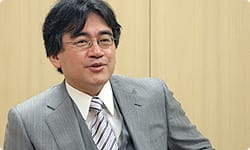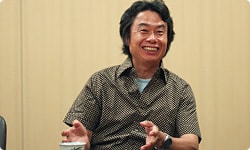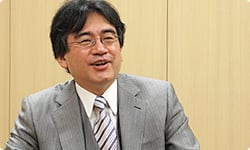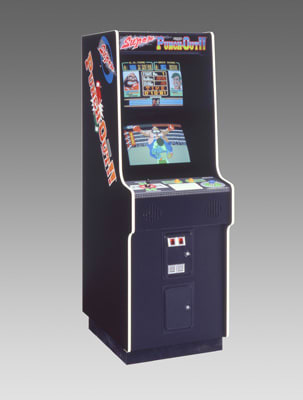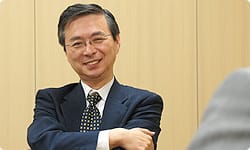Drawing Pixels on Giant Graph Paper
There was one more thing going on when we made Punch-Out!!.
What was that?
Up until that point, in pixel images, we had been drawing every image one by one, but we had started basic experiments with drawing rough sketches and loading them directly into the game. Then it would be possible to have even professional animators draw for us…
Actually, I think it was a little different… (laughs)
Different? (laughs)
Well, this story is 25 years old. There are bound to be some differences in memory. (laughs)
The tool for importing pictures as they were drawn by an animator wasn't remotely useable.
(laughs)
That's why we printed giant, desk-sized sheets of graph paper and drew everything by hand.
You could import that though…
Actually, importing that as data just made it easier for the programmer, but not for the designer.
(laughter)
Because we had to draw giant pixel images, all by hand. It was just a process that automated inputting the pixel images we drew with a scanner.
So you drew all of the images, Miyamoto-san? There are some pretty unique opponents in the game.
Up until that point, I had been drawing everything myself, but I got scared when I had to draw the big boxers for Punch-Out!!. I thought there was no way I could draw them with my drawing ability.
Like needing to display them at 1.5 times with the zoom function, you needed to make much bigger drawings than usual.
So I drew several pictures of boxers and I took them to (Takao) Kozai-san's Studio Junio10, in Tokyo.
He was the animator for New Star of the Giants, and Sally the Witch, right?
| 10 | Studio Junio: The animation company established by the animator Takao Kozai after he left Toei Motion Pictures. The current name is Junio Brain Trust. |
Right. That was the first time I had ever associated with an animator. I explained things to him while he looked at the pictures in a café, and he complemented me by saying, "You sure draw interesting pictures." No matter how I looked at them though, they were poorly done.
(laughter)
He spends all day looking at well-drawn pictures, so a unique picture is more…
Probably more interesting. (laughs)
So he apparently thought my drawings contained a lot of ideas. When he said, "You draw really great pictures," it was really encouraging to me. I came back to Kyoto all excited about that, and after a week, my original drawings came back as beautiful cells. They were colored in pretty colors and I thought that now they really looked like boxers. (laughs)
That's why I said that we had outsourced to a professional animator.
That was the only part that was the same. (laughs)
(laughter)
Rather than having everything after that automated, it was a huge job. (laughs) First we showed the cells to Takeda-san, and he liked them, so we designed them parts by parts. The punch, jab, and other arm movements, the side view of the face, were all divided into various parts and we had them all made into cells.
So they could be animated.
So we got the cells back, enlarged them, and put them on the giant tracing paper I mentioned before, and we transferred them one by one to pixel images. But I couldn't do all of it alone, so I drew the outline and woman who was assisting me colored it. Then we brought it to Takeda-san.
It sounds like that took a lot of effort. (laughs)
I don't remember that very well. Was the tool finished when we did Super Punch-Out!!11?
I think so. I remember it was really hard work when we did Punch-Out!!, but much of Super Punch-Out!! was automated. The first game was really hard work, but it was fun. It was the first time I'd gotten to work with animators and it lead to me meeting Mr. Kotabe12 and Mr. Maeda13, who used to draw Dr. Slump. I asked him to do illustrations when we made Zelda and we worked on Excitebike together.
Being worried about not being able to draw pictures of big boxers lead to a lot of things down the road. (laughs)
That's right. To me, Punch-Out!! was a game that created a lot of connections with a lot of people.
Did you draw anything besides the pixel art?
I drew the player and the referee. That's why the quality of those characters is a big step down from the opponents that Studio Junio drew. (laughs)
Mario and Donkey Kong are also in the audience.
That's right. I was trying to put Mario in a lot of other games, so I thought this was a good opportunity. Also, you can see camera flash in the stadium and I think I was the first in the world to do that.
| 11 | Super Punch-Out!!: An arcade action game released in 1985 as a sequel to Punch-Out!!. |
| 12 | Mr. Kotabe: Mr. Yoichi Kotabe created the cartoon Heidi of the Alps. He joined Nintendo after leaving Toei Animation and he was involved in the character design, etc. of Mario. Currently works as a freelancer. |
| 13 | Mr. Maeda: Mr. Minoru Maeda is an animator. He was the chief animation director for several hits such as Dr. Slump/Arare-chan, Dragonball, Touch, etc. |
The sequel, Super Punch-Out!!, was released in…
The next year, in 1985.
Arcade Machine Super Punch-Out!! |
Thanks to everyone, Punch-Out!! was a big hit. We were getting lots of reports saying that they were getting a lot of coins put in them, so people were asking us to make a sequel. We didn't know what to do. We did everything we could do with boxing. The only thing we could do was to include illegal moves, and that's why we made it so anything goes and had characters who would kick, or were like martial artists, and that became Super Punch-Out!!.
You had crossed the limits of a boxing game.
The last half has some incredible moves. Like one guy jump kicking from rope to rope. (laughs)
It wasn't supposed to be a pro wrestling game. (laughs)
That was all Takeda-san, the free-wheeling man.
We had a serious discussion about having them carry weapons. But we decided that it would be too strange. (laughs)
(laughter)
How were you related to that project, Miyamoto-san?
I was just providing support with the images, so I wasn't really involved with the final fine-tuning process, either.
Still, I'm having a hard time imagining the two of you in deep discussion while working on Punch-Out!! in the past as you two have just explained. (laughs) But those are your roots.
Super Punch-Out!! was the last one we worked together on though.
That's right. Until the Nintendo 64 era…
I was already in the hardware division by then.
So Super Punch-Out!! was the last game you developed together. I'd like to ask Miyamoto-san what he thinks the characteristics of Takeda-san's game design are.
In one word: free-wheeling.
Like the name Pizza Pasta. (laughs)
He has a very active imagination. That's why there was a lot to learn from him. For example, when given a difficult new request, a lot of people would think, "How am I supposed to do that?" Takeda-san is the kind of person who thinks, "Let's somehow find our own way to do it."
In the era when there were no standard formula on how to make video games in the first place, there were two schools of thought: the people who went to companies that could make videogames and the people who would try and make games themselves. Takeda-san raised the banner of the latter, and he is still driving this era at Nintendo. He was just a little too ahead of his time.
Ahead of his time?
Now with Wii, motion sensors are taken for granted, but at the time, a glove interface was a little ahead of its time.
I see. (laughs)

